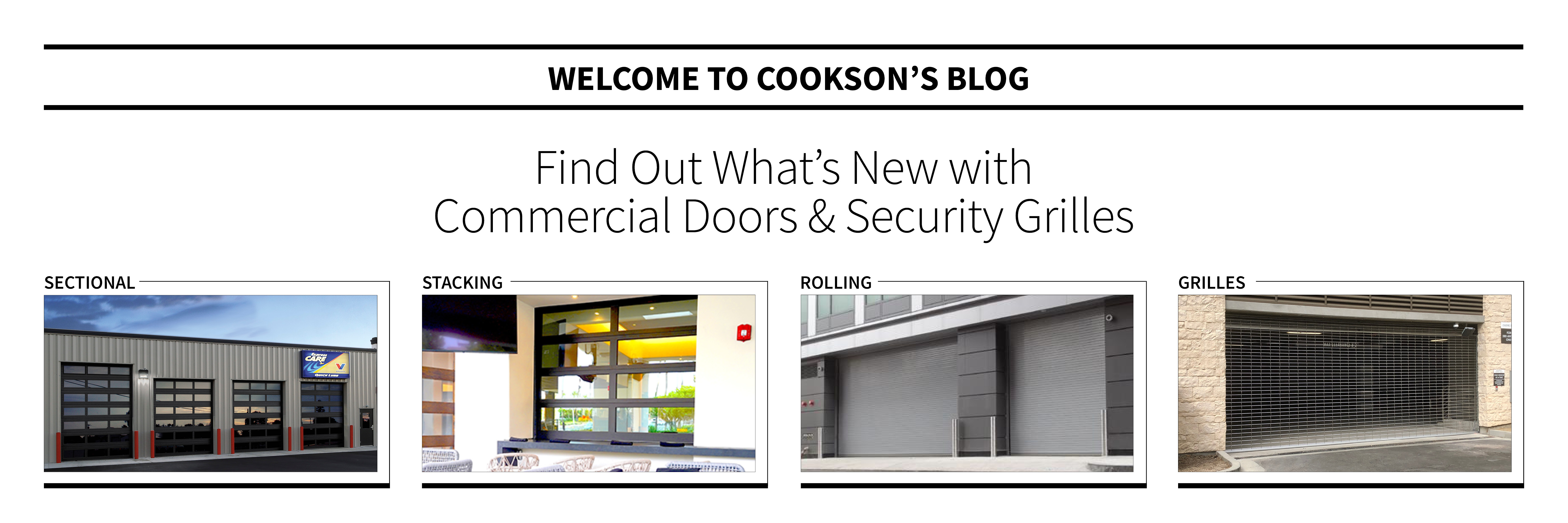

Cookson Blog
Welcome to the Cookson Blog! - Roll Up Door and Security Grille news - What's New?
SUBSCRIBE
Get updates on new blog posts to your inbox!
Springless Wind & Hurricane Resistant Security Doors
Hurricanes Incoming
Hurricane season is looming. Winds are whirling up and preparing for their debut in June. Meteorologists predict an above-average hurricane season in 2021 for the sixth-consecutive above-average year. Are you ready? Is your facility?

As hurricane season approaches, you may be weighing options for new or updated operable wind loaded doors in your critical facility. But how do you know if your facility needs an operable wind load door?
Wind Load Door Determinants
You may already know if your facility requires doors to be both wind loaded and operable in a high-wind event. If you’re unsure, there are a few routes you can take. Just as a hurricane has a best track (a representation of a tropical cyclone’s location and intensity over its lifetime), we also need to know where the door will be located and what intensity it will endure (cycle-wise and wind load-wise).
First, consider what type of facility you have.
Is it a critical facility that provides care or transport in emergency situations such as a hospital or ambulance stationhouse? Is it a fire station poised to rush out a moment’s notice to a blazing fire or to help someone trapped in debris? How about an airport or airport storage area that consistently deals with high winds from plane takeoffs and landings?
Maybe your facility is located on a military base and needs to be on alert (and up and running) during extreme weather. Or perhaps it’s a mine storage area that comes into contact with high winds on a mountainside? The time to weigh your options is not immediately after a high wind warning or hurricane local statement are released.
Risk categories of buildings are determined by International Building Code (IBC) 1604.5. This covers the risk category and nature of a building’s occupancy from buildings that represent a low hazard to human life in the event of a failure to ones with substantial risk, and also buildings designated as essential facilities. These essential facilities include structures such as:
- emergency treatment facilities,
- fire, rescue, ambulance, and police stations and emergency vehicle garages,
- designated earthquake, hurricane, or other emergency shelters, to name a few.
Whatever your facility encounters, it’s safe to assume if you work within public health or public emergencies, you may need an operable wind load rolling door.
So what exactly is an operable wind load door?
It’s all in the name: a door that is operable and wind loaded means it can function and cycle during high and severe winds – whether from Mother Nature or manmade.
Static wind load specifies the maximum wind load that a rolling door or grille is able to withstand while remaining closed. Operable wind load specifies the maximum wind load a rolling door or grille is able to safely operate.
If you install a door or grille that isn’t made for operable wind load and it encounters a severe wind event, it can lead to at “best,” a broken door and guides, and damaged equipment, and at worst, a blown-off roof and damaged building. The same holds true for a building’s walls and roof – both must be able to handle intense winds since a wind loaded door will distribute the forces across the structure as a whole.
One of the most important things to understand in the world of wind load for security rolling doors (and grilles) is that wind load is not just the measure of the wind speed a closure will have to withstand, whether operable or not.
.jpg?sfvrsn=57a4086d_0&MaxWidth=400&MaxHeight=400&ScaleUp=false&Quality=High&Method=ResizeFitToAreaArguments&Signature=A3EAFFD25B206B65884A7B3911229B16A9ABD566) Calculating Wind Load
Calculating Wind Load
Wind load is calculated in pounds per square foot for design load (the combination of the door’s total weight combined with the wind pressure forces on the door). It also includes these calculations as final determinants of what PSF a door should have:
- Mean roof height
- Roof slope
- Surrounding topography
- Exposure category
- Directionality factor
- Door area
- Importance factor
- Zone
- Positive or negative pressure
- Internal building pressure
A solution? Cookson's Wind-Master® Door.
In a situation where you need a door that can cycle in high winds and bad weather, you may want to consider Cookson’s Wind-Master® Door. Made to operate in design wind loads of 20 psf with its roller end locks/wind locks which allow the door to almost effortlessly move through the guides without damage when encountering high winds.
While this may seem counterintuitive, you want the door to move along with wind gusts so the guides or curtain aren’t damaged by straining in the guides. The Wind-Master allows for this billowing while still securing the door in the guides, taking pressure off the door and structure itself, even when cycling.
Our Wind-Master Door also features a springless design to remove resistance while letting the full weight of the door to assist in operation during severe winds. A heavier curtain gauge provides added weight, a benefit in this situation for critical facilities in need of operable wind loaded doors. To ensure safety, an inertia brake as a standard safety feature will prevent the door from free falling, and a motor operator does the heavy lifting and cycling, reducing risk of injuries.
In facilities with emergency responders, military forces, and other critical care staff, it’s important to use an operable wind loaded door. Protect the people working tirelessly to save others during hurricanes and high winds by first making sure the security closures will operate and function properly in a severe weather event.

Don’t get lost in a whirlwind of information. Check out our basics blogs on wind load here:
Want an expert to guide you through wind load requirements? Contact us: https://www.cooksondoor.com/contact-us.





